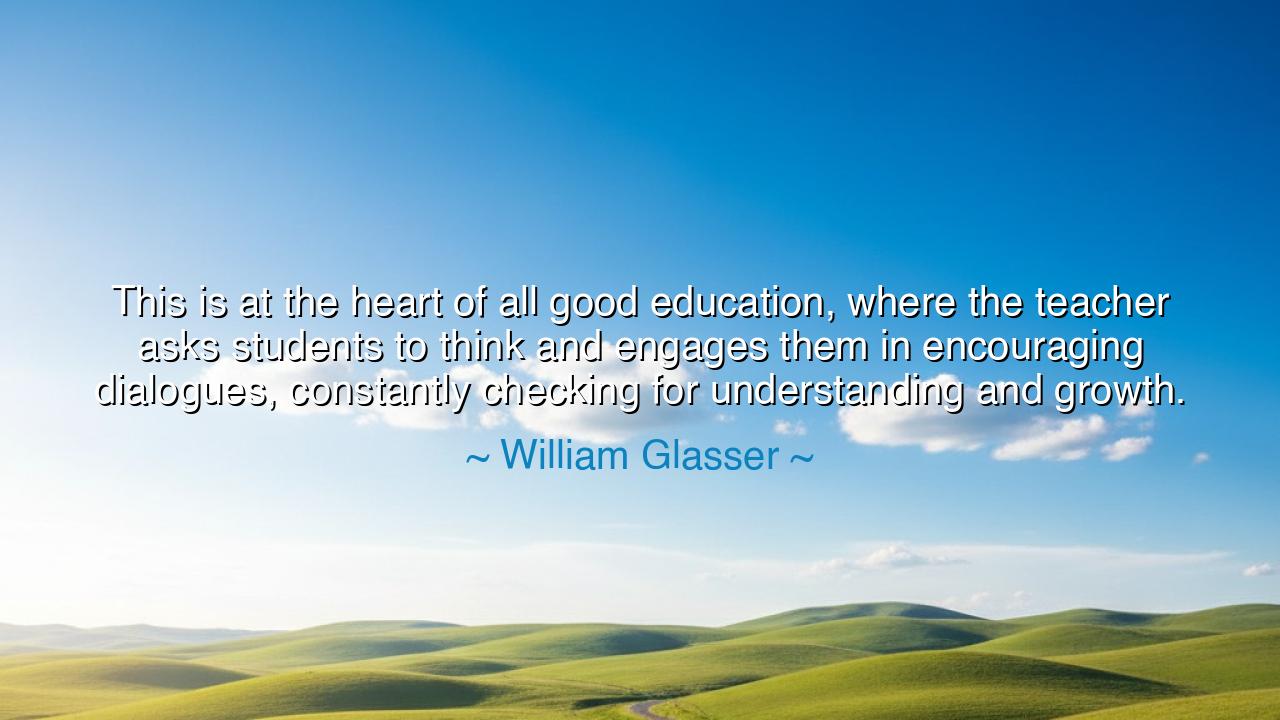
This is at the heart of all good education, where the teacher
This is at the heart of all good education, where the teacher asks students to think and engages them in encouraging dialogues, constantly checking for understanding and growth.






“This is at the heart of all good education, where the teacher asks students to think and engages them in encouraging dialogues, constantly checking for understanding and growth.” – William Glasser
In these thoughtful and luminous words, William Glasser, the distinguished psychiatrist and founder of Choice Theory, unveils the essence of true education—not as the mere transfer of facts, but as the awakening of minds. His vision stands in contrast to the mechanical repetition of lessons and memorization of data. Instead, Glasser sees education as a living dialogue, a sacred conversation between teacher and student where curiosity becomes the flame and understanding, the light it casts. The teacher, in this vision, is not a distant authority but a guide, a mentor, a cultivator of thought, inviting each student to think deeply and grow in self-knowledge.
The meaning of this quote lies in its elevation of education from instruction to transformation. Glasser reminds us that the heart of good teaching is not in the telling, but in the asking—not in delivering answers, but in nurturing inquiry. A great teacher does not fill a vessel but kindles a fire; they do not dictate truths but draw forth the truth within the learner. This process, Glasser suggests, depends on dialogue, the sacred exchange through which both teacher and student refine one another. When a teacher asks a question that demands reflection, when they listen patiently to a student’s struggle to form understanding, they are shaping not just knowledge, but wisdom.
The origin of Glasser’s insight comes from his lifelong dedication to understanding human behavior and motivation. He believed that true learning could only occur when students were internally motivated, when they felt ownership of their learning journey. His revolutionary ideas rejected the punitive and hierarchical systems of traditional education, replacing them with cooperation, mutual respect, and dialogue. For Glasser, the classroom was not a place of obedience, but of awakening—a place where the mind could grow only when it was free to question, to make mistakes, and to discover truth through engagement.
This ideal of learning through dialogue echoes ancient traditions. Socrates, the philosopher of Athens, taught not through lectures but through conversation. He asked his students questions that unsettled their assumptions and compelled them to think for themselves. His method—now known as the Socratic Dialogue—was built upon the same foundation Glasser describes: that growth happens through thoughtful questioning, reflection, and discussion. Socrates did not aim to create followers but thinkers, and in that legacy, Glasser found a kindred spirit. True education, then as now, is not the memorization of wisdom, but the creation of understanding through dialogue.
A living example of this truth can be found in Maria Montessori, who revolutionized education in her own time. She believed, as Glasser did, that children learn best when guided, not commanded; when invited to explore, not ordered to obey. In her classrooms, the teacher was a silent observer and gentle guide, constantly checking for understanding and growth, just as Glasser describes. She did not measure success by tests or grades, but by the unfolding of confidence, curiosity, and independence within the child. Both Montessori and Glasser teach us that when education honors the individuality of the learner, it becomes a pathway not only to knowledge but to freedom of thought.
The power of Glasser’s words also lies in their reminder that education is not a one-time act but a continuous process—a living dialogue that never ends. A teacher’s role, then, is not only to instruct but to listen, to challenge, to encourage. A true teacher recognizes that the mind, like a seed, grows best when tended with patience, watered with questions, and given sunlight through encouragement. They check not for memorization but for growth, not for performance but for progress. Such teaching transforms the classroom into a community of learning, where both teacher and student journey together toward understanding.
The lesson of Glasser’s quote reaches beyond schools and into the broader landscape of life itself. For we are all both teachers and students, constantly learning from the world and one another. To live wisely is to engage in dialogue—with others, with ideas, and with ourselves. Ask questions that deepen your understanding. Listen not merely to reply, but to comprehend. Measure your growth not by what you have learned, but by how deeply you have understood. And when you guide others—whether as a parent, mentor, or friend—remember that to truly teach is to invite another soul to think, not to command them to agree.
Thus, as William Glasser teaches, the heart of good education beats not in the sound of lectures but in the rhythm of shared thought. The teacher who asks rather than dictates, who listens rather than lectures, who inspires rather than instructs—this is the true architect of wisdom. For knowledge gained without reflection fades like ink in the rain, but knowledge discovered through dialogue endures like stone carved by patient hands. Let us, then, in every sphere of life, teach and learn as Glasser envisioned: with humility, with curiosity, and with a constant commitment to understanding and growth.






AAdministratorAdministrator
Welcome, honored guests. Please leave a comment, we will respond soon